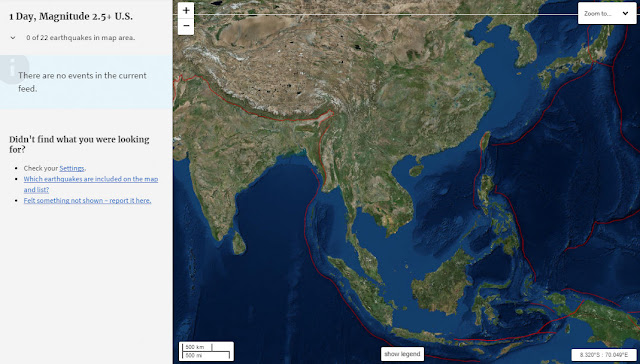 |
| Photo: Aljazeera |
 |
| JTWC satellite image June 23, 2017 |
 |
| JTWC satellite image June 24, 2017 |
 |
| PAGASA weather advisories June 24, 2017 |
 |
| 'There are no events in the current feed' - USGS (June 24, 2017)* |
For this entire region to have no significant earthquakes in a day is curious by itself though this could just be a lull before a big one, who knows?
But on this same day today, June 24, comes the shocking, even bizarre news that a tragic landslide in China has occurred without any strong wind, typhoon nor earthquake triggering it.
Maybe the Chinese authorities should really get into the very bottom of this. Who knows at this time of our lives in a world in chaos if something more sinister is going on?
Waking up Marinduque?
More importantly, a new and urgent lesson to be gained from this landslide could open the eyes at last of people living in certain island provinces particularly those where a network of dams in mine sites exist. Abandoned earth dams that have been long declared, even by USGS, 'in imminent danger of collapse'. That's in addition to areas that have been declared areas 'prone to landslides and floods'. Exactly the situation in the island of Marinduque, where else, the one that seemingly just went back to sleep again?
We're just running out of time, don't you think?
China landslide buries houses, scores missing
| AFP/Getty Images |
There is an extensive network of dams in the area, which is close to the region of Tibet, including two hydropower plants in Diexi town near the buried village.
A researcher from the Chengdu Chinese Academy of Social Science, a state-backed think tank, told China Radio International that heavy rainfall probably caused the slide.
The researcher, who the radio did not name, also warned of the risk that a dam could collapse, endangering communities further downstream.
The area is prone to earthquakes, including one in 1933 that resulted in parts of Diexi town becoming submerged by a nearby lake, and an 8.0 magnitude tremor in central Sichuan's Wenchuan county in 2008 that killed nearly 70,000 people.
Another report from CNN on the China episode:
"Earthquakes, mining activities -- many man-made and natural activities can possibly trigger landslides. When the stability of the mountain structure has reached its maximum, any triggering factor could lead to landslides," Tian said.
Mountainous Sichuan province has a history of landslides triggered by flooding and earthquakes. In 1933, 6,800 people died in landslides triggered by an earthquake and 2,500 more were killed when one of the landslides caused a dam to fail.
Another from Aljazeera:
At least 15 people have been confirmed dead, while over 120 remain missing hours after a massive landslide buried a mountain village in southwest China.
China's official news agency Xinhua issued the updated death toll at 1400 GMT on Saturday. Earlier, state media reported that 141 people may have been buried but did not explain why the figure had been revised downwards.
The landslide hit the village of Xinmo, in Maoxin county of Sichuan province, at about 6am local time on Saturday (22:00 GMT Friday), the agency reports said.
A couple and a baby were rescued and taken to hospital after 62 homes in Xinmo were destroyed by boulders when the side of a mountain collapsed, according to the Maoxin county government.
A fourth survivor was found but rescuers were still trying to get to him hours after heavy rain triggered the avalanche of rock in Sichuan province, officials said.
The landslide also blocked a 2km-section of a river. Wang Yongbo, a local rescue official, told state broadcaster CCTV that an estimated three million cubic metres of earth and rock had slid down the mountain.
Xinmo is known locally for tourism and Chinese reports said it was unclear if tourists were among the people buried by the landslide.
*Update: On June 25, 2017, after significant earthquakes go strangely quiet the day before, USGS recorded the following earthquakes ranging from M4.3 - 5.2 with M4.5 and M4.8 striking northern and southern Philippines respectively:

